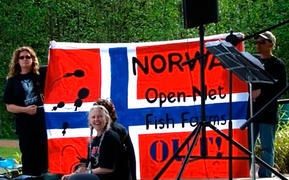New for you: Unbelievably for us at Callander McDowell, reLAKSation is now in its nineteenth year. The intention from the outset was to comment on stories in the news. The first mailings were even called ‘Views on the News’. Now after all these years, we are introducing a new item, and this is Martin’s Blog which may delve deeper into issues of interest.
Martin’s Blog 1: Many regular readers will know that I have written a book – Loch Maree’s Missing Sea Trout – available on Amazon. As I researched the book, I became increasingly keen to hear the views of people from the wild fish sector as to my findings. Some agreed to meet whilst others refused and still refuse. Someone suggested that I should seek the views of those working at Marine Scotland Sciences’ Freshwater Fisheries Laboratory at Pitlochry. Two years ago, I wrote to MSS to ask if I could visit. I received the following response:
There has been formal scientific analysis of variation in salmon counts (Ford & Myers, 2008) and catches (Vøllestad et al., 2009) between east and west coasts of Scotland. We have also compared catches and pre-fisheries abundance of salmon and trout in the “aquaculture region” with those elsewhere, as summarised in a briefing that is now posted on our website All these analyses show that indices of wild salmon abundance in the aquaculture zone, or west coast, have declined relative to those in other areas as aquaculture production has increased.
At the beginning of August, I finally met with members of MSS and Marine Scotland, but rather than discuss my views on the impacts of salmon farming on wild fish stocks, I was informed that:
We have reached a consensus based on international research data that there is a relationship between salmon farming and wild migratory salmonids.
For Scottish Ministers and Marine Scotland (MS), the question is no longer whether there is a relationship or not, but what reasonable and proportionate action should be taken to control this relationship.
Marine Scotland Science have posted a summary of the science on the Scottish Government website. The relevant section of the pages titled ‘The Interaction and Effects of Sea Lice on Wild Salmon’ states:
Is there an effect of salmon lice on wild salmon at the population level?
Declines in catches of wild salmon have been steeper on the Scottish west coast than elsewhere in Scotland and Norway (Vøllestad et al. 2009) although the authors stressed that this did not prove a causative link with aquaculture. Ford & Myers (2008) compared indices of salmon abundance on the East and West coasts of Scotland together with farm production data. They found a reduction in the catches and counts of salmon on the west coast correlating with increased production of farmed salmon. In addition, Butler & Watt (2003) showed that rivers with farms had significantly lower abundances of juvenile salmon than those without farms.
Experiments comparing survival of smolts treated or untreated with anti-sea lice medicines have shown that sea lice adversely affect certain salmon populations in Norway and Ireland (e.g. Vollset et al. 2015). There is a great deal of year-to-year and site-to-site variability in the magnitude of such impacts and the reduction in numbers of returning salmon associated with lice infestations is in the range of 0-39% (Jackson et al. 2013; Krkošek et al. 2013; Skilbrei et al.2013; Vollset et al. 2015). A meta-analysis of all available Norwegian studies showed anti-lice treatment increased returns of adult salmon by an average of 18% (Vollset et al. 2015). It is not clear in these studies how much of the estimated impact of lice is due to baseline natural levels in the environment and how much is associated with an additional effect caused by salmon aquaculture.
No information exists on impacts of lice on wild populations of salmon in Scotland. However, the estimated mean effect size of lice seen in other countries is of a similar magnitude to the difference between the aquaculture zone and east coast of Scotland in the reduction in abundance of wild salmon determined using data from fish counters (Ford & Myers 2008). It is not clear how much of this regional variation may be due to factors besides aquaculture.
There are several issues arising from this short section, but most notably is the fact that none of the papers cited are dated after 2015. This raises the question that if this international research forms the basis of the decision that there is a relationship between salmon farming and wild fish, then why have MSS spent the last three years and £600,000 trying to identify what relationship does exist. Perhaps, if they had proved the relationship, I wouldn’t ask that question but the three-year SARF project failed to identify anything other than there were not enough smolts available to carry out a full study; something that was already clearly obvious.
The second paper to be cited in MSS’s summary of the Science is Ford & Myers 2008, a paper that was discussed in the last issue of reLAKSation. The paper looks at wild fish populations in a number of countries where salmon farming occurs. The summary states:
Through a meta-analysis of existing data, we show a reduction in survival or abundance of Atlantic salmon; sea trout; and pink, chum, and coho salmon in association with increased production of farmed salmon. In many cases, these reductions in survival or abundance are greater than 50%. Meta-analytic estimates of the mean effect are significant and negative, suggesting that salmon farming has reduced survival of wild salmon and trout in many populations and countries.
The paper was published in PLOS Biology, a peer reviewed open access journal and as a peer-reviewed study, MSS undoubtedly do not question its validity, however, I do. In last week’s issue, reLAKSation discussed whether the graphs of Scottish catches and counts supported the assertions made by the authors.
For my part, I think that there is more to research than peer review. There are some that believe that such peer review should be questioned https://www.timeshighereducation.com/blog/peer-review-way-validating-research-bunk but rather than focus on the validity of the peer review I would like to approach the Ford & Myers paper in a different way.
As this paper appears to be central to the issue of whether salmon farming has an impact on wild fish populations, I was keen to know more about the main author Jennifer Ford. It seems that the second author Ransome Myers passed away in the year of publication. There doesn’t seem to be much information about Ms Ford. She collaborated on a couple of other papers and then she appears to have moved on to other things. The Ford & Myers paper was published in February 2008, but this was not her first paper. In December 2007, Jennifer Ford co-authored a paper that appeared in Science. The lead author was Martin Krkosek and amongst the six authors along with Ms Ford was Alexandra Morton – a well known anti-salmon farming activist based in Canada. The paper is titled ‘Declining Wild Salmon Populations in Relation to Parasites from Farm Salmon’.
Part of the abstract of the paper states:
The louse-induced mortality of pink salmon is commonly over 80%. If outbreaks continue then local extinction is certain and a 99% collapse in pink salmon populations abundance is expected in four salmon generations.
At the time, there was a massive reaction to this paper. The following week Brian Riddell and others responded in Science by saying that the paper’s forecast was inconsistent with observed pink salmon returns. The papers’ authors responded the following week attempting to clarify any misunderstandings in a Technical Comment. A further critic was later published in ‘Reviews in Fisheries Science’ by Brooks and Jones which again was refuted by the authors in the same journal. I do not intend to delve into the arguments that raged at the time, but would point out that most of the research relied on computer-generated modelling. This can be demonstrated by the fact that at the time Martin Krkosek worked for the Department of Mathematical and Statistical Sciences. His department is part of the Centre for Mathematical Biology at the University of Alberta. Instead of considering his modelled forecasts, I would prefer to focus on a report that appeared in the Globe and Mail in 2013 that was headlined ‘Pink salmon reaching Fraser River in massive numbers’. The DFO scientists had forecast a run of about 12 million pinks for 2013 but the number of fish entering the river was estimated at around 26 million fish. Other rivers were also experiencing huge returns. It seems that the predicted extinction of pinks in the locality was way off the mark!!
According to Business in Vancouver, Morton and Krkosek later said that any recovery of wild stocks was the result of salmon farms being pressurised into changing the way they manage sea lice outbreaks. Yet in 2015, a team from the University of Toronto led by Andrew Bateman were claiming that poor management of sea lice by salmon farms had seen increased sea lice infections on wild pink salmon. By coincidence, Andrew Bateman’s supervisor and co-author was Martin Krkosek. It has been previously pointed out that the three main directors at the Salmon Coast Field Station, established by Alexandra Morton are Ms Morton, Martin Krkosek and Andrew Bateman.
Writing in her blog, Alexandra Morton’s latest entry (August 2108) states:
This spring was the 18th year of sea lice research and I was devastated by the sight of the tiny schools of young salmon leaving the Ahta and other rivers of the Broughton. Where there should have been millions, there were tens. I have failed. This is what extinction looks like.
Interestingly, her entry for September 2017 states:
Meanwhile there are less than 200 pink salmon in the Ahta River. There should be thousands. I have personally witnessed the death of thousands of Ahta River pink salmon as the pass the Marine Harvest sites, Glacier Falls and Wicklow and the Cermaq site Burdwood as they are lethally infected with sea lice. This is what extinction looks like.
In September 2005, Alexandra Morton wrote on the Save our Skeena Salmon website:
the Ahta River, a virgin watershed unaffected by logging has only 200 pink salmon.
Alexandra Morton’s many claims generate a passionate response from those associated with the salmon farming industry. Odd Grydeland wrote an opinion piece for Fish Farming Expert back in 2015.
“Dr” Morton does it again
The extreme anti-salmon farming activist Alexandra Morton once again shows that her words can be far from the truth.
Over the 30-something years that I have been involved with the salmon farming industry in British Columbia and elsewhere, few issues have been more frustrating to deal with than the never-ending, mostly ill-informed accusations thrown into media circles by the self-described and media referenced “Scientist” “Researcher” “Biologist” Alexandra Morton, who also was given an honorary PhD by the Simon Fraser University in Vancouver, where she has found professors willing to collaborate on some dubious and questionable research projects.
The fact that some of these projects were actually published in otherwise respectable journals allowed Ms Morton to be accepted as a member of the College of Applied Biology as a Registered Professional Biologist some years ago.
This college now also stipulates that its members must complete an ethics course: “To be considered acceptable by the College, the professional ethics course must include a discussion on what it means to be a professional and on the elements of professional practice such as competence, independence, integrity, due diligence, and accountability”.
However, what upset Mr Grydeland at that time was the publication of a picture of Ms Morton with a Norwegian flag covered with images of sea lice. Of interest to many in Scotland is that Don Staniford is also in the photo. In my opinion, these associations surely undermine the credibility of these peer reviewed papers which now form the basis of Marine Scotland’s sea lice policy.

Yet, the story doesn’t end there.
The Ford and Myers paper reveals that the major funder of their work was the Lenfest Ocean Programme. Lenfest Ocean Programme funds scientific research on policy relevant topics concerning the world’s oceans. They were founded in 2004 by the Lendfest Foundation but are managed by the Pew Charitable Trusts. They say that their interest in aquaculture is:
Sustainable Marine Aquaculture
The impacts of marine aquaculture—the farming of species like salmon, shrimp and tuna—range from sea-bed pollution and coastal habitat degradation to introduction of non-native species and capture of massive quantities of wild fish for fish feed. The Lenfest Ocean Program invests in research that identifies sustainable approaches to marine aquaculture. Projects in this category include those that quantify the effects of aquaculture on the surrounding environment and communities or that identify innovative methods to reduce environmental impacts.
I had heard of Lenfest before reading the Ford & Myers paper. They feature on a schematic drawn up by independent Canadian researcher Vivian Krause. This shows some of the funding pathways used by some of the large US Charitable Foundations to channel $33 million into campaigns to undermine the salmon farming industry and to make farmed salmon unappealing to US consumers.

Not surprisingly, the Lenfest Ocean Programme also funded the work by Martin Krkosek, Jennifer Ford, Alexandra Morton and others along with the David Suzuki Foundation and Tides Canada. Vivian Krause extensively details her exchanges with the David Suzuki Foundation questioning their approach to salmon farming. This has not changed over the years. In April this year David Suzuki engaged in a debate with Alf Helge Aarskog of Marine Harvest. The Vancouver Sun reported that David Suzuki told Mr Aarskog:
Pinks around the Broughton Archipelago (fish farms) have been dropping catastrophically and they are the most abundant species. We’ve got to stop using the oceans as a garbage can. It’s crystal clear that the oceans are in deep trouble. When I look at these fish farms, the science tells me they should never have been there in the first place.
The US Foundations withdrew most of their funding around 2010 because their campaign ultimately failed to persuade US consumers to stop eating farmed salmon. This has not discouraged some environmental groups from continuing their anti-salmon farming stance as they still hope to persuade the public that salmon farming has a major negative impact on the environment, despite indications to the contrary. Of course, there are some who are still persuaded by this ‘evidence’, because of the peer review. In my opinion, MSS fall into this category. This is not surprising given that their historical role has been the of support wild fish interests. What is now of most concern is that Scottish Government policy appears to have been dictated by anti-salmon farming activists rather than hard facts. I, for one, will continue the fight to demonstrate that the impacts of salmon farming on wild fish stocks are not as claimed.
魚和薯條 : The Daily Mirror has revealed the shortlist of twenty fish and chip shops competing for the 2019 Fish and Chip awards. The newspaper asks ‘is your favourite on the list?’ The simple answer is no and this is not surprising since the awards have little to do with how they are perceived by. or their appeal to chip shop aficionados. This is because fish and chip shops enter themselves for the competition. This is why the shortlist includes two branches of the same fish and chip shop chain. Like all other entrants they are seeking publicity of the business, such as that given by the Daily Mirror. Our favourite local fish and chip shop always has queues of eager customers lining up out of the door and into the street so probably aren’t that interested in attracting more business.
According to Seafish, the National Fish and Chip Shop Awards is now in its 31st year and they say that the media activity undertaken by Seafish in relation to the awards generates fantastic publicity for both participating businesses and the wider fish and chip sector. With this aim in mind, we, at Callander McDowell would argue that the current competition should be scrapped and instead this year’s prize should be immediately awarded to Scotts Fish and Chip Shop.
Scotts have done more than any other fish and chip shop to raise awareness and publicity of fish and chips than all the shortlisted fish and chip shops combined and more importantly, they have not sought the accolade themselves.
For readers of reLAKSation not in the UK, or who have avoided the media recently, Scotts Fish and Chip shop has received extensive TV, radio and newspaper coverage. They are located well away from the coast or a major town. In fact, they are situated on a busy main road outside York, next to a McDonalds, a BP petrol station and a Premier Inn hotel. They are just outside a small village. Most potential customers probably drive past at 70 mph an hour and don’t even notice the chippy.
The reason why Scotts have hit the headlines is the way that they have adapted their business to meet changing customer needs and these customers are coach loads of Chinese tourists. Since the then UK Prime Minister and the Chinese Premier ate fish and chips for lunch in an English pub, there has been a growing interest amongst tourists from China in eating the UK national dish. Scotts are on the main road leading to York and to Castle Howard.
Scotts have adapted their business to serving a large number of customers in a very short time whilst making these overseas visitors extremely welcome. They have had their menu translated into Chinese and they provide photo opportunities for visitors keen to take as many photos as possible of the restaurant and the staff. Scotts have shown how a traditional English Fish and Chip shop can become a real tourist destination. The shop is featured in a York visitor guide sent to airlines, airport lounges and visa offices in China. Over 35,000 leaflets have been distributed. The shop has even featured on TV in China. This year they have seen a fifteen-fold increase in Chinese coach parties.

The fish and chip sector should not only applaud, but also celebrate Scott’s enterprise. They have created a great deal of publicity for the sector and should be recognised as fish and chip ambassadors, worthy of the industry’s top award. Our congratulations to Scotts Fish and Chips.


